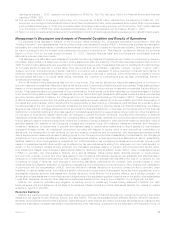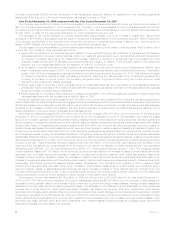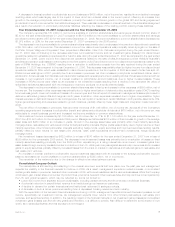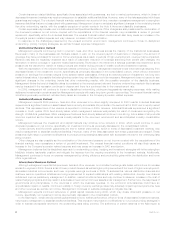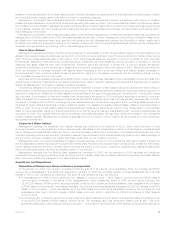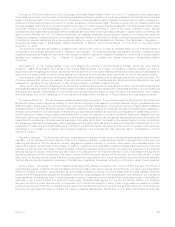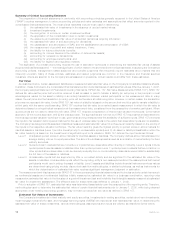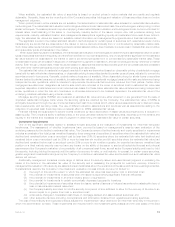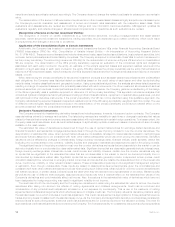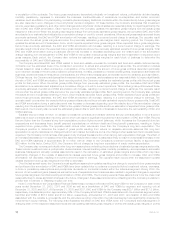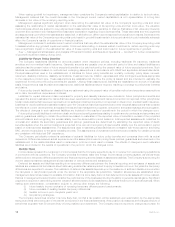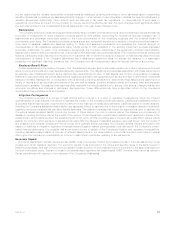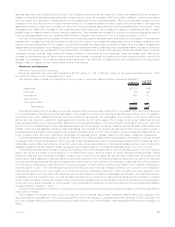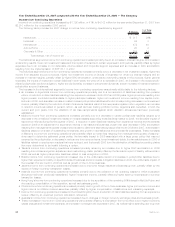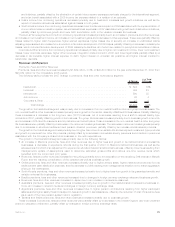MetLife 2008 Annual Report Download - page 18
Download and view the complete annual report
Please find page 18 of the 2008 MetLife annual report below. You can navigate through the pages in the report by either clicking on the pages listed below, or by using the keyword search tool below to find specific information within the annual report.in part due to the netting agreements and collateral arrangements that are in place with all of its significant derivative counterparties. The
evaluation of the requirement to make an additional credit risk adjustments is performed by the Company each reporting period.
The accounting for derivatives is complex and interpretations of theprimaryaccountingstandardscontinuetoevolveinpractice.
Judgment is applied in determining the availability and application of hedge accounting designations and the appropriate accounting
treatment under these accounting standards. If it was determined that hedge accounting designations were not appropriately applied,
reported net income could be materially affected. Differences in judgment as to the availability and application of hedge accounting
designations and the appropriate accounting treatment may result in a differing impact on the consolidated financial statements of the
Company from that previously reported. Assessments of hedge effectiveness and measurements of ineffectiveness of hedging relation-
ships are also subject to interpretations and estimations and different interpretations or estimates may have a material effect on the amount
reported in net income.
Embedded Derivatives
Embedded derivatives principally include certain variable annuity riders and certain guaranteed investment contracts with equity or bond
indexed crediting rates. Embedded derivatives are recorded in the financial statements at estimated fair value with changes in estimated
fair value adjusted through net income.
The Company issues certain variable annuity products with guaranteed minimum benefit riders. These include guaranteed minimum
withdrawal benefit (“GMWB”) riders, guaranteed minimum accumulation benefit (“GMAB”) riders, and certain guaranteed minimum income
benefit (“GMIB”) riders. GMWB, GMAB and certain GMIB riders are embedded derivatives, which are measured at estimated fair value
separately from the host variable annuity contract, with changes in estimated fair value reported in net investment gains (losses).
The estimated fair value for these riders is estimated using the present value of future benefits minus the present value of future fees
using actuarial and capital market assumptions related to the projected cash flows over the expected lives of the contracts. The projections
of future benefits and future fees require capital market and actuarial assumptions including expectations concerning policyholder
behavior. A risk neutral valuation methodology is used under which the cash flows from the riders are projected under multiple capital
market scenarios using observable risk free rates. Beginning in 2008, the valuation of these embedded derivatives now includes an
adjustment for the Company’s own credit and risk margins for non-capital market inputs. The Company’s own credit adjustment is
determined taking into consideration publicly available information relating to the Company’s debt as well as its claims paying ability. Risk
margins are established to capture the non-capital market risks of the instrument which represent the additional compensation a market
participant would require to assume the risks related to the uncertainties of such actuarial assumptions as annuitization, premium
persistency, partial withdrawal and surrenders. The establishment of risk margins requires the use of significant management judgment.
These riders may be more costly than expected in volatile or declining equity markets. Market conditions including, but not limited to,
changes in interest rates, equity indices, market volatility and foreign currency exchange rates; changes in the Company’s own credit
standing; and variations in actuarial assumptions regarding policyholder behavior, and risk margins related to non-capital market inputs
may result in significant fluctuations in the estimated fair value of the riders that could materially affect net income.
The Company ceded the risk associated with certain of the GMIB and GMAB riders described in the preceding paragraphs. The value of
the embedded derivatives on the ceded risk is determined using a methodology consistent with that described previously for the riders
directly written by the Company.
The estimated fair value of the embedded equity and bond indexed derivatives contained in certain guaranteed investment contracts is
determined using market standard swap valuation models and observable market inputs, including an adjustment for the Company’s own
credit that takes into consideration publicly available information relating to the Company’s debt as well as its claims paying ability. Changes
in equity and bond indices, interest rates and the Company’s credit standing may result in significant fluctuations in estimated the fair value
of these embedded derivatives that could materially affect net income.
The accounting for embedded derivatives is complex and interpretations of the primary accounting standards continue to evolve in
practice. If interpretations change, there is a risk that features previously not bifurcated may require bifurcation and reporting at estimated
fair value in the consolidated financial statements and respective changes in estimated fair value could materially affect net income.
Deferred Policy Acquisition Costs and Value of Business Acquired
The Company incurs significant costs in connection with acquiring new and renewal insurance business. Costs that vary with and relate
to the production of new business are deferred as DAC. Such costs consist principally of commissions and agency and policy issuance
expenses. VOBA is an intangible asset that reflects the estimated fair value of in-force contracts in a life insurance company acquisition and
represents the portion of the purchase price that is allocated to the value of the right to receive future cash flows from the business in-force
at the acquisition date. VOBA is based on actuarially determined projections, by each block of business, of future policy and contract
charges, premiums, mortality and morbidity, separate account performance, surrenders, operating expenses, investment returns and other
factors. Actual experience on the purchased business may vary from these projections. The recovery of DAC and VOBA is dependent upon
the future profitability of the related business. DAC and VOBA are aggregated in the financial statements for reporting purposes.
DAC for property and casualty insurance contracts, which is primarily composed of commissions and certain underwriting expenses, is
amortized on a pro rata basis over the applicable contract term or reinsurance treaty.
DAC and VOBA on life insurance or investment-type contracts are amortized in proportion to gross premiums, gross margins or gross
profits, depending on the type of contract as described below.
The Company amortizes DAC and VOBA related to non-participating and non-dividend-paying traditional contracts (term insurance,
non-participating whole life insurance, non-medical health insurance, and traditional group life insurance) over the entire premium paying
period in proportion to the present value of actual historic and expected future gross premiums. The present value of expected premiums is
based upon the premium requirement of each policy and assumptions for mortality, morbidity, persistency, and investment returns at policy
issuance, or policy acquisition, as it relates to VOBA, that include provisions for adverse deviation and are consistent with the assumptions
used to calculate future policyholder benefit liabilities. These assumptions are not revised after policy issuance or acquisition unless the
DAC or VOBA balance is deemed to be unrecoverable from future expected profits. Absent a premium deficiency, variability in amortization
after policy issuance or acquisition is caused only by variability in premium volumes.
The Company amortizes DAC and VOBA related to participating, dividend-paying traditional contracts over the estimated lives of the
contracts in proportion to actual and expected future gross margins. The amortization includes interest based on rates in effect at inception
15MetLife, Inc.


